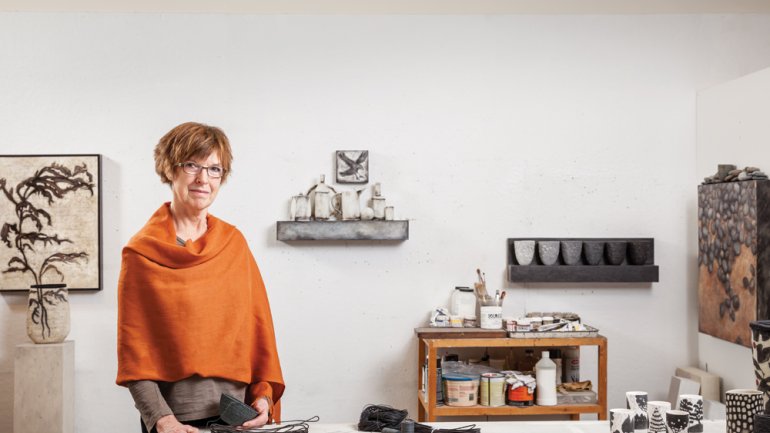Creative Continuum
Creative Continuum
An accomplished fibert artist looking for a change, Lissa Hunter found working with clay both familiar and fresh.
The walls and shelves of Lissa Hunter’s airy studio in downtown Portland, Maine, bear a rich assortment of vessels and drawings, providing a 35-year timeline of her work, mostly in fiber.
Coiled baskets sit atop counters and shelves, their surfaces covered in paper – in some cases drawn on – the tones earthy and deep. Others are coated in encaustic wax, drawn into with designs. One particularly striking piece rests atop a pedestal, its off-white exterior decorated with an illustration of a dried branch whose leaves extend up and onto a framed charcoal drawing on a gessoed wood panel placed above it, an evocative blending of forms.
A nearby tabletop displays yet another body of work: rows of ceramic vessels, a medium the artist had next to no hands-on familiarity with until three years ago, when she followed the urge to break away from basketry.
Hunter’s fiber sculptures have brought her awards and been purchased by collectors and museums, including the Smithsonian’s Renwick Gallery and the Museum of Fine Arts, Boston, but she’d found herself aching for a change.
“A few years ago I was feeling as if I was repeating myself a lot with the basketry. I felt inauthentic,” says Hunter, who holds two fine arts degrees and was a tenured assistant professor at Mansfield University of Pennsylvania until 1979, when she left to pursue art full-time.
She can’t pinpoint why or how she chose ceramics.
“You have something that works for you just below the level and you’re not sure what it even is,” she explains. “I probably saw some work that resonated and thought, ‘Oh, that’s what pottery could be.’ It also helped that there was a pottery studio four blocks away, it wasn’t expensive, and I liked the teacher.”
In late 2011, Hunter started attending basic classes at Portland Pottery, learning how to build porcelain vessels both by coiling and slabs. Coiling felt familiar thanks to basketry, while the new medium enlivened the conversation between the material and her hands.
About two years later, she committed herself to ceramics even more, investing in an electric kiln.
“For two years, I thought, ‘This is just something I’m playing around with.’ I’m from Indiana – we don’t jump right into things,” she says with a laugh. “Even though it wasn’t hugely expensive, buying the kiln made it more real.”
Surveying the clay vessels in her studio, their tones, shapes, and designs convey a continuation of her aesthetic and physicality as much as they do a switch in materials.
“It’s really all about the process,” she says. “That’s the key. Materials are a partner in the process.” Some of the ceramic pieces are sculptural and stand alone, while others are combined in visual collections that hark back to her basketry tableaux. One grouping of small black-and-white vessels with drawings on the surface represents Hunter’s first functional work – tumblers for juice, wine, or whatever.
“People can use them! How exciting is that?” she says with a look of delight. “I’ve never had to think about size and surface in this way before.”
For those, she employs sgraffito to achieve a graphic look, first brushing on a coat of black underglaze and then scratching away to reveal white lines and eventually form shapes, or wiping away to reveal the white porcelain underneath. Some of her pieces are covered with images of rocks, water, and plants. (She keeps boxes of objects, including dried leaves and branches, in her studio for inspiration.) Others show appealing domestic scenes, including one ringed with clothes hanging on a line, complete with grass and dog.
Craft Gallery in Rockland, Maine, has featured her new work in three shows, and the response has been enthusiastic. Still, Hunter does not consider herself a ceramic artist, nor has she closed the door on fiber.
“I’d never say ‘I’m a potter.’ I say ‘I’m working with clay.’ I don’t know glazes, I don’t know a lot, and it’s not my community, though the community has been very generous of spirit. It some ways it’s more collaborative than basketmaking because of sharing kiln space, things like that.”
Hunter plans to keep her ceramic forms simple and straightforward. “What I’m most interested in is ways of drawing on the surface. In that way, I can be in charge and it’s mine,” she says. “Of all the mediums, I feel like drawing is the most difficult thing to do. It’s just you and this thing you do.”
Whatever form art takes, Hunter says, artists relaying what moves them is elemental, whether it is, in her case, assorted rocks and branches, a murder of crows, or laundry hanging on the line.
“It’s an artist’s job – and it’s what’s thrilling as an artist – to look at the world, try to understand it, and try to manifest that understanding into something that someone can tune into – even if it’s something you drink your juice out of.”
Craft Gallery in Rockland, Maine, will show new work by Lissa Hunter in July. Diane Daniel is a writer based in Florida and the Netherlands.

